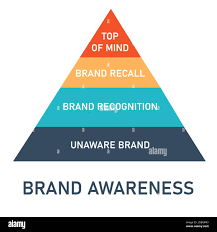Brand Recognition: Why It Matters and How to Achieve It
In today’s competitive marketplace, building a strong brand is essential for any business hoping to succeed. One of the key components of a successful brand is brand recognition. Put simply, brand recognition refers to the ability of consumers to identify and recall your brand in a crowded market.
Why Does Brand Recognition Matter?
Brand recognition is important for several reasons. Firstly, it helps to build trust and credibility with consumers. When people recognize your brand, they are more likely to feel familiar with it and trust it over unknown brands. This can lead to increased sales and customer loyalty.
Secondly, brand recognition can help you stand out in a crowded market. With so many brands vying for attention, being easily recognizable can help you cut through the noise and get noticed.
Finally, strong brand recognition can lead to increased word-of-mouth marketing. When people recognize your brand and have positive associations with it, they are more likely to recommend it to others.
How Do You Achieve Brand Recognition?
So how do you go about building strong brand recognition? Here are some tips:
- Consistency is key: Ensure that all aspects of your branding – from your logo and color scheme to your messaging – are consistent across all channels.
- Be memorable: Create a unique visual identity that stands out from the crowd.
- Focus on quality: Deliver high-quality products or services that exceed customer expectations.
- Engage with customers: Build relationships with your customers by engaging with them on social media or through other channels.
- Invest in advertising: Consider investing in advertising campaigns that will help increase awareness of your brand among your target audience.
- Leverage influencers: Partnering with influencers who have large followings can be an effective way to increase exposure for your brand.
- Measure success: Track metrics such as website traffic, social media engagement, and sales to measure the success of your branding efforts.
In conclusion, brand recognition is a vital component of building a successful brand. By focusing on consistency, memorability, quality, engagement, advertising, influencer partnerships, and measurement, you can increase the chances that consumers will recognize and recall your brand in a crowded marketplace.
Answers to 9 Common Questions About Brand Recognition
- What is brand recognition?
- How do you measure brand recognition?
- How can I increase my brand recognition?
- What are the benefits of strong brand recognition?
- How does brand recognition affect customer loyalty?
- What strategies can be used to improve brand recognition?
- How does social media impact brand recognition?
- How does pricing influence brand recognition?
- What are the best practices for building a recognizable brand?
What is brand recognition?
Brand recognition is the ability of consumers to identify and recall a particular brand, often through visual or auditory cues such as logos, slogans, or jingles. It is a measure of how easily a brand can be recognized and distinguished from other brands in a crowded market. Strong brand recognition can lead to increased trust, customer loyalty, and word-of-mouth marketing. Building and maintaining strong brand recognition is an important component of building a successful brand.
How do you measure brand recognition?
Measuring brand recognition can be a challenging task as it involves gauging the level of familiarity that consumers have with your brand. However, there are several methods you can use to measure brand recognition, including:
- Surveys: Conducting surveys is one of the most common ways to measure brand recognition. You can ask consumers questions such as “Have you heard of our brand?” or “Can you identify our logo?” to gauge their familiarity with your brand.
- Social media engagement: Monitoring social media engagement can also be a useful way to measure brand recognition. By tracking metrics such as likes, shares, and comments on your social media posts, you can get an idea of how many people are engaging with your brand and how frequently.
- Website traffic: Tracking website traffic can also give you an idea of how well-known your brand is. If more people are visiting your website, it could indicate that they are becoming more familiar with your brand.
- Search volume: Monitoring search volume for your brand name or related keywords can also be a useful way to gauge brand recognition. If more people are searching for your brand or related terms, it could indicate that they are becoming more familiar with it.
- Brand awareness surveys: Brand awareness surveys involve asking consumers questions about their familiarity with certain brands in a particular industry or category. This method allows you to compare the level of familiarity that consumers have with your brand compared to others in the same industry.
In conclusion, measuring brand recognition requires a combination of methods and metrics to get an accurate picture of how well-known your brand is among consumers. By using surveys, social media engagement, website traffic, search volume, and other methods, you can gain insights into the level of familiarity that consumers have with your brand and make informed decisions about future branding efforts.
How can I increase my brand recognition?
Increasing brand recognition requires a combination of strategic planning and consistent execution. Here are some practical steps you can take to enhance your brand recognition:
- Develop a strong visual identity: Your logo, color scheme, and overall visual style should be consistent across all channels, including your website, social media profiles, and marketing materials.
- Create valuable content: Publishing high-quality content that resonates with your target audience can help increase your brand’s visibility and establish you as an authority in your industry.
- Engage with your audience: Responding to comments and messages on social media, hosting Q&A sessions, and soliciting feedback from customers can help build stronger relationships with your audience.
- Leverage social media: Social media platforms like Facebook, Twitter, and Instagram are powerful tools for building brand recognition. Consistently sharing engaging content and interacting with followers can help increase visibility and engagement.
- Invest in advertising: Paid advertising campaigns on social media or search engines can help increase brand awareness among specific target audiences.
- Collaborate with influencers: Partnering with influencers who have large followings in your industry can help increase exposure for your brand among their followers.
- Attend industry events: Participating in trade shows or other industry events provides an opportunity to network with potential customers and showcase your products or services.
- Measure success: Regularly tracking metrics such as website traffic, social media engagement, and sales can help you assess the effectiveness of your branding efforts and make adjustments as needed.
By implementing these strategies consistently over time, you can enhance your brand recognition and establish a strong presence in your market.
What are the benefits of strong brand recognition?
Strong brand recognition can bring numerous benefits to a business, including:
- Increased trust and credibility: When people recognize your brand, they are more likely to feel familiar with it and trust it over unknown brands.
- Competitive advantage: In a crowded market, being easily recognizable can help you stand out from the competition and get noticed.
- Increased customer loyalty: Strong brand recognition can lead to increased customer loyalty as people tend to stick with brands they know and trust.
- Word-of-mouth marketing: When people recognize your brand and have positive associations with it, they are more likely to recommend it to others, leading to increased word-of-mouth marketing.
- Higher perceived value: A strong brand with high recognition is often perceived as having higher value than lesser-known brands.
- Easier product launches: If you already have strong brand recognition, launching new products or services under the same brand can be easier as consumers are already familiar with your brand.
- Better pricing power: Brands with high recognition often have better pricing power as consumers are willing to pay more for products or services from a trusted and recognized brand.
Overall, strong brand recognition is essential for building a successful business in today’s competitive marketplace. It can help you build trust and credibility with customers, stand out from the competition, increase customer loyalty, and drive word-of-mouth marketing.
How does brand recognition affect customer loyalty?
Brand recognition is a critical factor in building customer loyalty. When customers recognize and recall your brand, they are more likely to feel a sense of familiarity and trust towards it. This familiarity and trust can lead to increased customer loyalty over time.
When customers are loyal to a brand, they are more likely to make repeat purchases and recommend the brand to others. This can be incredibly valuable for businesses, as it can lead to increased sales and revenue.
One of the reasons why brand recognition is so important for customer loyalty is that it helps to create a sense of consistency and reliability. When customers see your branding consistently across different channels, such as social media, advertising, or packaging, they are more likely to feel that they know what to expect from your business.
Additionally, strong brand recognition can help to differentiate your business from competitors. In crowded marketplaces where there are many similar products or services available, having a recognizable brand can help you stand out from the crowd.
Overall, brand recognition plays a crucial role in building customer loyalty. By focusing on building strong branding that is consistent across all channels and creating positive associations with your brand through high-quality products or services and engaging with customers, you can increase the chances that customers will recognize and recall your brand over time. This familiarity and trust can lead to long-term customer loyalty that benefits both the business and the customer.
What strategies can be used to improve brand recognition?
Improving brand recognition requires a well-planned strategy that focuses on building a strong brand image and increasing its visibility. Here are some effective strategies that can be used to improve brand recognition:
- Consistency: Consistency is key when it comes to building a strong brand image. Ensure that all aspects of your branding – from your logo and color scheme to your messaging – are consistent across all channels.
- Unique visual identity: Create a unique visual identity that stands out from the crowd. This includes creating a distinctive logo, choosing a unique color palette, and designing eye-catching visuals.
- Quality products or services: Deliver high-quality products or services that exceed customer expectations. This will help build trust and credibility with consumers, which can lead to increased sales and customer loyalty.
- Engage with customers: Build relationships with your customers by engaging with them on social media or through other channels. Responding to customer inquiries, addressing complaints promptly, and sharing user-generated content are all effective ways to engage with customers.
- Advertising campaigns: Consider investing in advertising campaigns that will help increase awareness of your brand among your target audience. This can include social media advertising, display ads, search engine marketing, influencer partnerships, and more.
- Leverage influencers: Partnering with influencers who have large followings can be an effective way to increase exposure for your brand. Influencers can help amplify your message and reach new audiences who may not be familiar with your brand.
- Measure success: Track metrics such as website traffic, social media engagement, and sales to measure the success of your branding efforts. This will help you identify what’s working well and what needs improvement.
In conclusion, improving brand recognition requires a multifaceted approach that focuses on consistency, unique visual identity, quality products or services, customer engagement, advertising campaigns, influencer partnerships, and measurement of success over time. By implementing these strategies effectively over time, you can increase the chances that consumers will recognize and recall your brand in a crowded marketplace.
How does social media impact brand recognition?
Social media has become an integral part of our daily lives, and it has also had a significant impact on brand recognition. Social media platforms like Facebook, Twitter, Instagram, and LinkedIn have provided businesses with new ways to connect with their audience and build brand awareness.
Here are some ways in which social media impacts brand recognition:
- Increased Exposure: Social media platforms allow businesses to reach a wider audience than ever before. By creating engaging content and sharing it on social media, businesses can increase their exposure and reach potential customers who may not have heard of them otherwise.
- Brand Consistency: Social media provides businesses with a platform to showcase their brand identity consistently across all channels. By maintaining a consistent visual aesthetic and tone of voice across all social media channels, businesses can reinforce their brand identity in the minds of their audience.
- Customer Engagement: Social media allows for two-way communication between businesses and their customers. By responding to customer inquiries or complaints promptly, businesses can build trust with their audience and increase customer loyalty.
- Influencer Marketing: Social media influencers have become an essential part of the marketing mix for many brands. Partnering with influencers who align with your brand values can help increase your exposure to a wider audience while building credibility and trust.
- User-Generated Content: Social media platforms allow users to create and share content related to a particular brand or product. User-generated content (UGC) is valuable because it provides social proof that other people are using and enjoying your products or services.
In conclusion, social media has had a significant impact on brand recognition by increasing exposure, maintaining consistency across channels, fostering customer engagement, leveraging influencer marketing, and encouraging user-generated content. Businesses that leverage the power of social media effectively can enhance their brand recognition significantly over time.
How does pricing influence brand recognition?
Pricing is a critical factor in brand recognition as it can have a significant impact on consumer perceptions of a brand. The price of a product or service can signal to consumers the quality, value, and exclusivity of the brand.
In general, higher prices are often associated with higher quality products and services. This is because consumers tend to equate price with quality – the more expensive something is, the better they assume it must be. For example, luxury brands such as Gucci or Chanel command premium prices because they are perceived as exclusive and high-quality.
On the other hand, lower prices may signal to consumers that a brand is of lower quality or less exclusive. This is because low-priced products are often associated with budget or discount brands that prioritize affordability over quality.
However, there are exceptions to these generalizations. Some brands may intentionally set low prices to appeal to budget-conscious consumers, while others may set high prices to create an aura of exclusivity and luxury.
Ultimately, the key to leveraging pricing for brand recognition is understanding your target audience and their perceptions of value. For example, if your target audience values affordability above all else, setting low prices may be more effective than setting high ones. Conversely, if your target audience values exclusivity and luxury, setting high prices may be more effective in creating an image of prestige and quality.
In conclusion, pricing can have a significant impact on brand recognition by influencing consumer perceptions of a brand’s quality, value, and exclusivity. Understanding your target audience’s values and preferences is crucial in leveraging pricing for effective branding strategies.
What are the best practices for building a recognizable brand?
Building a recognizable brand takes time, effort, and a strategic approach. Here are some best practices for building a brand that is easily recognizable:
- Define your brand identity: Start by defining your brand identity, including your mission statement, values, and unique selling proposition. This will help you create a consistent message that resonates with your target audience.
- Develop a strong visual identity: Create a strong visual identity that includes your logo, color scheme, typography, and other design elements. Make sure these elements are consistent across all channels.
- Be consistent: Consistency is key when it comes to building a recognizable brand. Make sure all aspects of your branding – from your messaging to your visuals – are consistent across all channels.
- Focus on quality: Deliver high-quality products or services that exceed customer expectations. This will help build trust and credibility with consumers.
- Engage with customers: Build relationships with your customers by engaging with them on social media or through other channels. This will help create loyal customers who are more likely to recommend your brand to others.
- Invest in advertising: Consider investing in advertising campaigns that will help increase awareness of your brand among your target audience.
- Leverage influencers: Partnering with influencers who have large followings can be an effective way to increase exposure for your brand.
- Measure success: Track metrics such as website traffic, social media engagement, and sales to measure the success of your branding efforts.
- Stay true to your values: Finally, make sure you stay true to the values and mission of your brand at all times. This will help build trust and credibility with consumers over time.
By following these best practices for building a recognizable brand, you can increase the chances that consumers will recognize and recall your brand in a crowded marketplace.




